
Davis, Aron. The Poker Blueprint
.pdf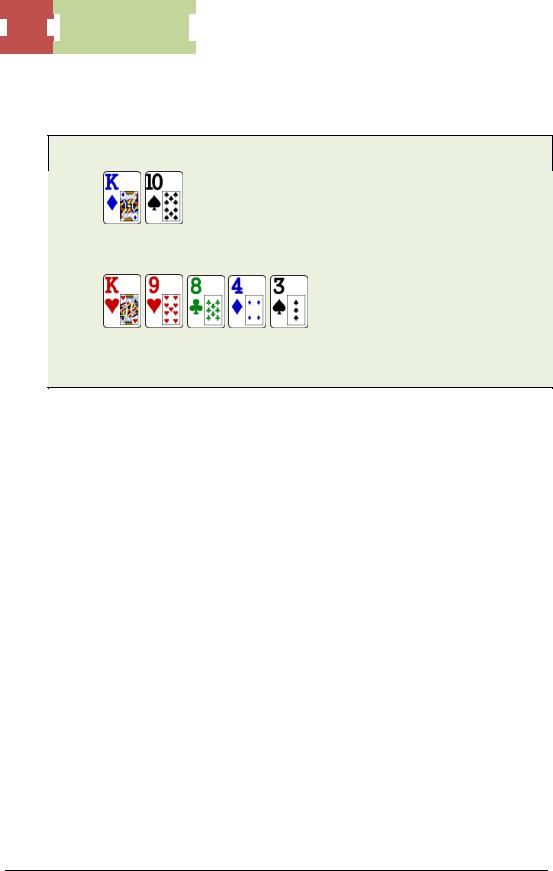
 39
39  Math is Easy
Math is Easy
Memorizing Numbers
You get to the river with
on
The pot is $100 and the preflop raiser shoves his entire stack of $75. How often do you have to be good here for this call to be profitable?
If you don’t know the answer to this right away, you’re going to be losing valuable time and energy doing it in the middle of a game (the answer is at least 30%).
These situations happen all the time in poker. Villain may bet half-pot or full-pot, or he might even over-bet the pot and you sit there trying to figure out the odds. Learn the math now, so that when these situations come up again, you can focus your attention on his hand range instead of the odds you need to make a profitable call.
I’ve already done all the hard work for you. I plugged all the numbers into the equations and organized the answers for you (on page 40). All you have to do now is memorize it.
Learning these charts is one of the easiest and fastest things you can do to immediately improve your poker game and win rate.
If I were to learn poker from the beginning again, this will certainly be one of my top priorities. Poker is all about having an edge over your opponents. Whether you know something they don’t or are capable of doing something and they’re not, you gain.
Knowing these charts is certainly one of those edges.
© 2010 Aaron Davis and Tri Nguyen - All Rights Reserved.
http://www.DailyVariance.com
39
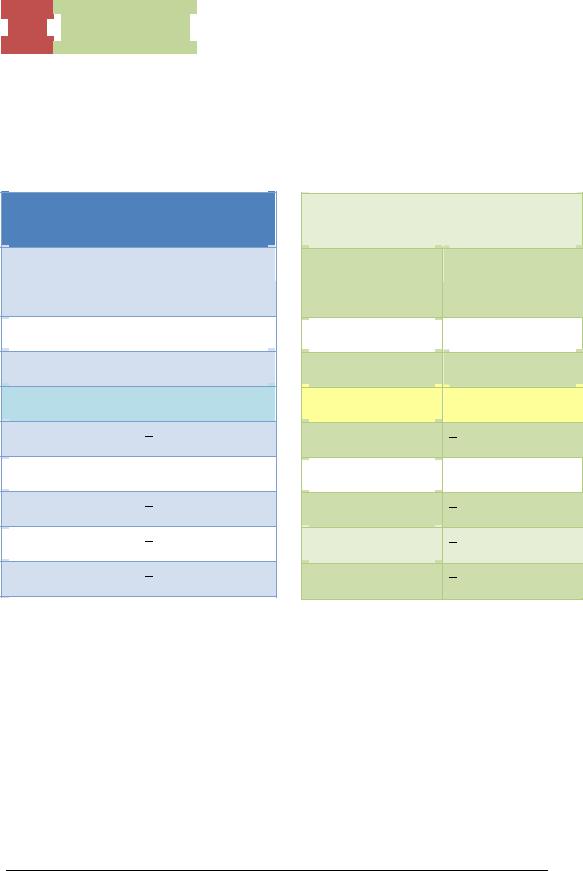
 40
40  Math is Easy
Math is Easy
Quick Poker Facts
(Memorizing these charts now will make your life much easier)
Bluffing Frequency on River |
Calling Frequency on River |
||
How often your |
|
How often we |
|
bluffs have to |
Your Bet Size |
must be ahead |
Villain’s Bet Size |
work to be |
|
for our call to be |
|
profitable |
|
profitable |
|
67% or more |
2x the pot size |
40% or more |
|
2x the pot size |
60% or more |
1.5x the pot size |
37.5% or more |
1.5x the pot size |
50% or more |
Pot size |
33% or more |
Pot size |
43% or more |
of pot size |
30% or more |
of pot size |
|
|
33% or more |
|
of pot size |
|
25% or more |
|
|
|
|
of pot size |
|
|
|
|
|
|
|
|
||||
|
|
|
|
|
|
|
|
|
||
|
|
|
|
|
|
|
|
|
25% or more |
of pot size |
20% or more |
of pot size |
|
|
20% or more |
of pot size |
17% or more |
of pot size |
|
|
||
17% or more |
of pot size |
14% or more |
of pot size |
|
|
© 2010 Aaron Davis and Tri Nguyen - All Rights Reserved.
http://www.DailyVariance.com
40

 41
41  Preflop: The Fundamentals
Preflop: The Fundamentals
Preflop: The Fundamentals
© 2010 Aaron Davis and Tri Nguyen - All Rights Reserved.
http://www.DailyVariance.com
41

 42
42  Preflop: The Fundamentals
Preflop: The Fundamentals
The Blinds
Look at positional stats in PokerTracker or Holdem Manager and you will find that you’re actually losing money in the blinds. The amount is probably a little more than you would like. This is the fate that most, if not all, poker player share because it’s very difficult to win money playing pots out of position. It’s difficult to extract value from your strong hands, and your range is more faced-up. You also give your opponent more information regarding the strength of your hand than vice versa.
When the decision to fold or call pre-flop is close, folding is better because a small mistake can lead to a bigger one post-flop. In the occasion that you do play and find yourself being out of position, try to keep the pots small so you won’t find yourself in many sticky situations.
Raising from the blinds
Be very conservative with your raises from the blinds. With a few limpers in the pot, don’t raise unless you’ve got a good hand like 99+, ATs+, AQo+, or KQs. Another thing to remember is that when you raise from the blinds after a few limpers, most people will put you on premium hands (AQ+, TT+). So, on a flop like AT3 rainbow, you’re not going to extract much value from weaker hands. Players will know what your range is and they have the opportunity to continue or not after you act. If you get raised here, then be very cautious against standard TAGs and especially NITs. Unless there is any history, if your c- bet gets raised, you should fold one pair in this spot. No one is going out of their way to make you fold AQ /AK on an AT3 flop.
3-betting From The Blinds
Against a UTG raise, the majority of your 3-bets should be for value. Unless I know UTG is a fish, I rarely 3-bet in this type of situation because my perceived range is so strong. An argument can be made that if my opponent thinks my range is strong, I should 3-bet with marginal holdings to make him fold his good hands. Although this reasoning is valid, I’m going to get called pre-flop a lot since Villain has position on me. If he is aggressive and good, he’s going to make my life pretty tough post-flop. My philosophy regarding poker is to put myself in situations to make simple decisions and avoid making costly one. This is one of those situations that I wish to avoid and I hope you do too.
Since we are rarely 3-betting a UTG open from the blinds, we should call with the majority, if not all our holdings. If you only 3-bet with the nuts, an observant opponent
© 2010 Aaron Davis and Tri Nguyen - All Rights Reserved.
http://www.DailyVariance.com
42

 43
43  Preflop: The Fundamentals
Preflop: The Fundamentals
will notice and will put a lot of pressure when you only call from the blinds. Besides, it’s not like we are giving up a lot of value by calling from the blinds. It is just one of those situations where no matter what you do, you aren’t going to get a lot of value out of it.
The sooner you accept this fact, the better your game will be and subsequently, your bankroll.
It is important to note that there are a lot of players who won’t notice that you are 3- betting from the blinds with only the nuts. In such situations, I would definitely 3-bet KK+ and try to get as much money in as possible. If you find a particular player who fold to 3- bets a lot, you can start 3-betting with marginal hands such as 98s and KQo. However, I would be cautious of such an approach. There are much better situations in an orbit of hands where your edge is bigger.
Against an MP open, the same principle applies, although you can widen your 3-betting range since your opponent’s opening range is wider and your perceived range is wider as well. It is important to note that you should try to have your range as wide as possible.
In this situational dynamic, you should 3-bet more often with JJ+/AK against looser opponents. If my opponent folds to 3-bets a lot, I wouldn’t 3-bet with JJ and AK and would call pre-flop to keep them in. I rarely flat call in this spot with QQ+ because it would be disastrous if I fail to stack my opponent’s premium holding. I would call with QQ+/AK only if I know the players who have yet to act is squeeze happy and will 3-bet if I call. If those players don’t exist at the current table, you lose too much value for not 3-betting pre-flop.
You shouldn’t be 3-betting with non-broadway suited connectors. They don’t play well in 3-bet pots and you won’t flop enough hands to continue after c-betting. Don’t 3-bet with weak suited Ax either. It doesn’t flop well and it is very tough to play post-flop. When you flop an ace, you rarely dominate your opponent and you only get action when you are behind.
Against opponents who rarely fold to 3-bets, tighten up your range by removing suited connectors. If they call 3-bets a lot and fold to c-bets when they miss, then go ahead and widen your 3-betting range to include suited broadway hands that are easy to play postflop.
Against a CO/BTN open, you should 3-bet with a wider range because his stealing range is wider. The question is which range should you be 3-betting with?
© 2010 Aaron Davis and Tri Nguyen - All Rights Reserved.
http://www.DailyVariance.com
43
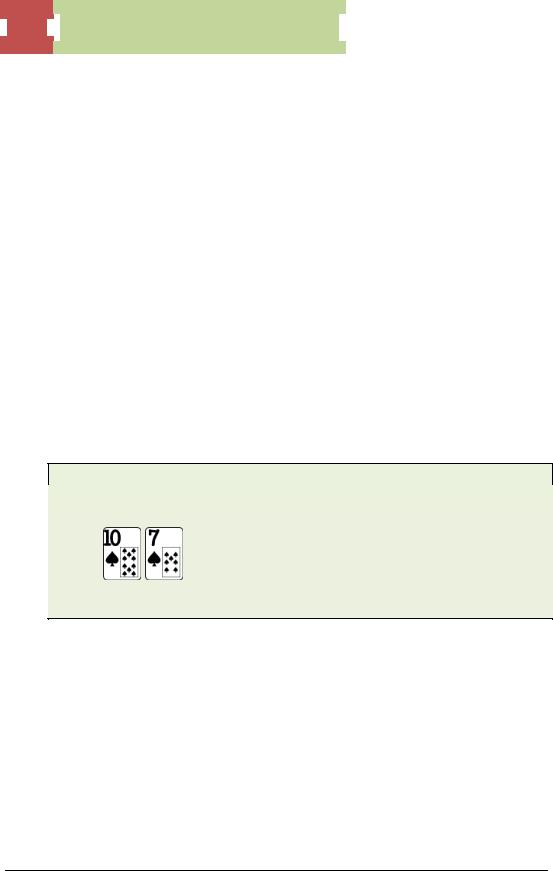
 44
44  Preflop: The Fundamentals
Preflop: The Fundamentals
In this type of situation, I would like to 3-bet with a polarized range. What this means is I would 3-bet with premium hands such as JJ+/AQ and speculative holdings such as 65s and 87s that can’t play profitably post-flop without the initiative. I would call with marginal hands such as AJ, KJ, QJ, and pocket pairs. The reason is by calling with AJ, KJ and QJ, I can keep some of the hands I dominate in the pot since worse hands are rarely calling my 3- bet. Sometimes I call from the blinds with AK/AQ as well to have some nut hands in my flatting range and for deception value. Some players like to 3-bet small pairs from the blind against the CO/BTN because it works well with their game. Since I don’t like to play out of position, I like to call with those holdings and make my decision post-flop.
Squeezing
Squeezing is when you re-raise a pre-flop raiser with another player in the pot. Unless you have a history of 3-betting a ton, this will look extremely strong and will give you a lot of respect and folds. Most of the time, the person squeezing will be from late position or from the blinds. At 50NL, a squeeze is usually a strong hand. At 600NL, ranges are wider and Villain can show up with speculative hands such as A4s, 75s, and KJo.
Here is a simple squeezing spot.
100 NL – 6 max. 100BB effective stacks.
A weak-tight UTG player limps and CO raises to $5. You have
on the Button. You 3-bet to $17.
The example above illustrates that you can 3-bet to punish a habitual isolator, whose range in this spot is likely wide. Squeezing also discourages the CO from playing more hands because he has to worry about you.
Another squeeze spot is when a loose player opens in MP or in the CO and the BTN calls. If you are in the blinds, then this is a good squeezing spot. The main reason is when a loose player opens, the BTN has a wider value range to 3-bet with. So when the BTN only calls, the majority of his calling range is marginal holdings such as small pocket pairs, QTs, and ATs. Let’s stop for a second. If you have JJ+/AQ+ on the BTN and a loose player opens in the CO, what would you do? You would 3-bet the majority of the time because your hand is so ahead of your opponent’s range and your hand dominate some of the hands he
© 2010 Aaron Davis and Tri Nguyen - All Rights Reserved.
http://www.DailyVariance.com
44

 45
45  Preflop: The Fundamentals
Preflop: The Fundamentals
calls a 3-bet with. This is the main reason why good players always advocate folding marginal holdings on the BTN or CO against an early position open if there is a squeeze happy player on the blinds.
While squeezing is a powerful play, it can easily be misused. Learn the guidelines below to prevent yourself from making mistakes that cost you money.
-Squeeze until they give you a reason to stop: If they don’t adjust by either 4-betting you light or start shoving flops lightly against your c-bet, then there’s no reason to stop. Keep running them over. You will be surprised to see so many players willing to let you have your way. If a player, especially a regular, has been folding to your 3- bets, suddenly 4-bets you, then fold anything worse than AK and QQ. He isn’t leveling nor adjusting against you. He has the nuts.
-Villain’s Hand Range: A good, tight-aggressive player’s hand range for calling your 3- bets consist of 88+, AQ, KQs, QJs, JTs, T9s, 98s, and 87s. On a flop like A73 rainbow, you should consider betting your entire range since you have a lot of fold equity. And because it’s a flop where you can have a lot of combinations of strong hands in your range (AT+), your betting range is easily balanced with air. For this reason, just bet one-half to three-fifth pot. There’s no reason to bet bigger since hands that are behind your made hands aren’t going to outdraw you often. Betting small also allows you to bluff cheaply on future hands.
-Ace high flops: If you 3-bet with TT-KK OOP and the flop comes Axx, you should betfold more often than check-call. Although you won’t often get called by worse, it makes the hand easier to play, especially if your opponent is aggressive. Of course, if your opponent is passive and let you get to showdown easily, then checking is fine.
-Against NITS: Don’t squeeze a NIT when he raises from early position because his range will be too tight and strong.
-Against loose-bad players: Don’t squeeze loose, bad players with low suited connectors. They will call your 3-bets and c-bets too often that it’s just not profitable. It’s much better to just call their raise preflop and stack them when you hit something big.
-Against shortstacks: Don’t squeeze when there’s a short stack in the hand and you don’t want to call his all-in raise. He’s not going to fold often, and will just jam with
© 2010 Aaron Davis and Tri Nguyen - All Rights Reserved.
http://www.DailyVariance.com
45
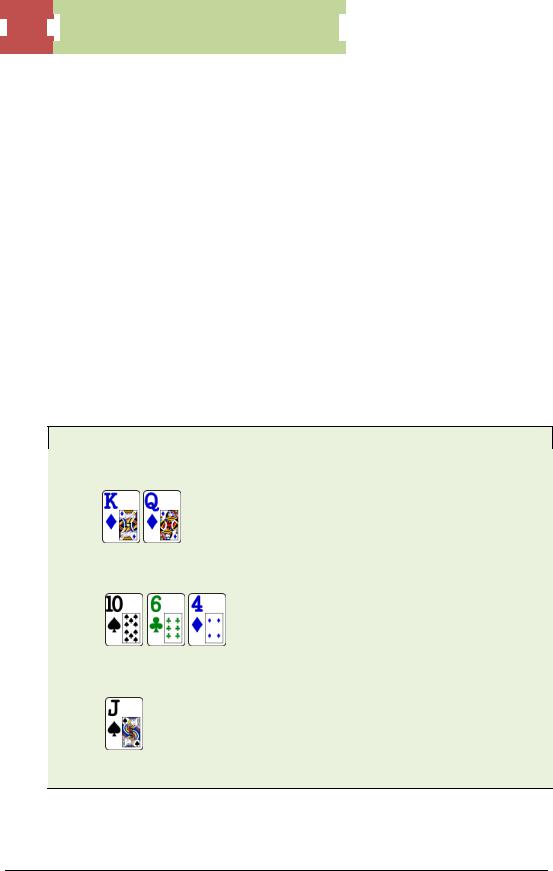
 46
46  Preflop: The Fundamentals
Preflop: The Fundamentals
any A or any pair. AT+ or 77 are decent hands to squeeze with but stay away from medium or low suited connectors.
- Against light 4-better: Don’t squeeze against an opponent who 4-bets you back frequently. This won’t happen much at lower stakes, although it’s something to keep in mind as you move up.
After Villain calls your squeeze, never bet unless you think he will fold a lot or you are willing to get it in on the turn. It’s very exploitable to always check-fold the turn after you bet the flop. Good players will pick up on this and you will lose a lot of money. Fewer players are capable of detecting this at micro-stakes or small stakes, but be aware of it.
His hand range for calling the flop mostly consists of weak-type hands or even overcards if he’s tricky. You should be betting the turn a ton of the time against players like him. Unless he’s stubborn and calls you down lightly, it’s tough for him to do anything about it.
Here’s another example.
100 NL – 6 max. 100BB effective stacks.
MP opens $4. CO calls $4. You squeeze to $16 with
MP folds and CO calls. The flop is
You bet one-half pot and Villain calls. The turn is a
What is your play?
You should consider betting three-fourth pot or near pot to commit yourself. Don’t bet so small that he would take it as weakness and shove over your bet with a pair or a draw.
© 2010 Aaron Davis and Tri Nguyen - All Rights Reserved.
http://www.DailyVariance.com
46
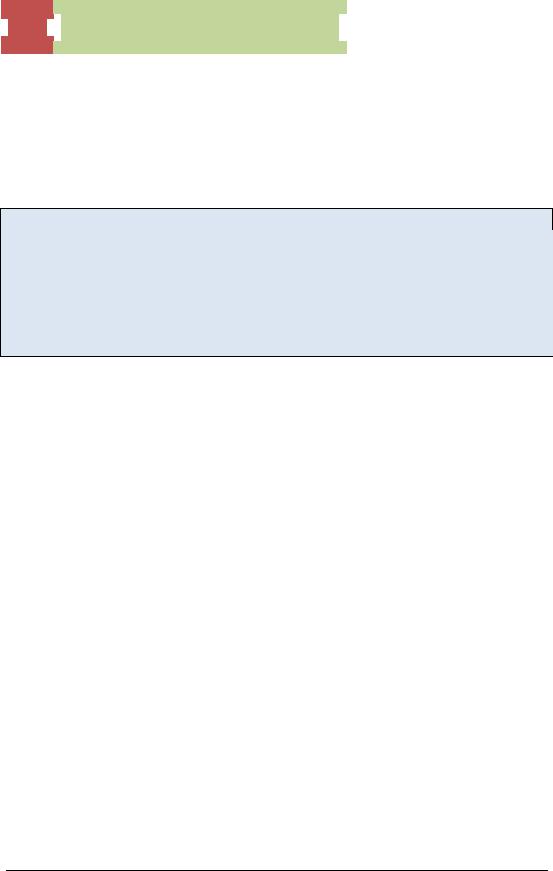
 47
47  Preflop: The Fundamentals
Preflop: The Fundamentals
Most of Villain’s range will be Tx, 77-99, 98s, 87s (occasionally 6x and A4s), and cannot continue on the turn. You have tons of equity (overcards and OE) to make the best hand against a hand like ATs. If he shows up with a set, you can always suck out. On the same note, if he can show up with a set on this board, he’ll have a lot of other pocket pairs in his range that will fold to the turn bet.
Caution: Squeezing a lot will build up adrenaline and you may find yourself playing too aggressively to the point of spazzing out like a monkey. You will also find yourself more incline to fight for pots because the pots are bigger. I suggest taking a conservative approach at first by squeezing with only QQ+/ AK+ so you are comfortable playing in 3-bet pots. Once you’re more comfortable and recognize some spots where your opponents fold all the time, you can add speculative hands such as 87s, ATs, and KJs to your range. I would also practice playing in 3-bet pots against weaker players at the table first.
© 2010 Aaron Davis and Tri Nguyen - All Rights Reserved.
http://www.DailyVariance.com
47
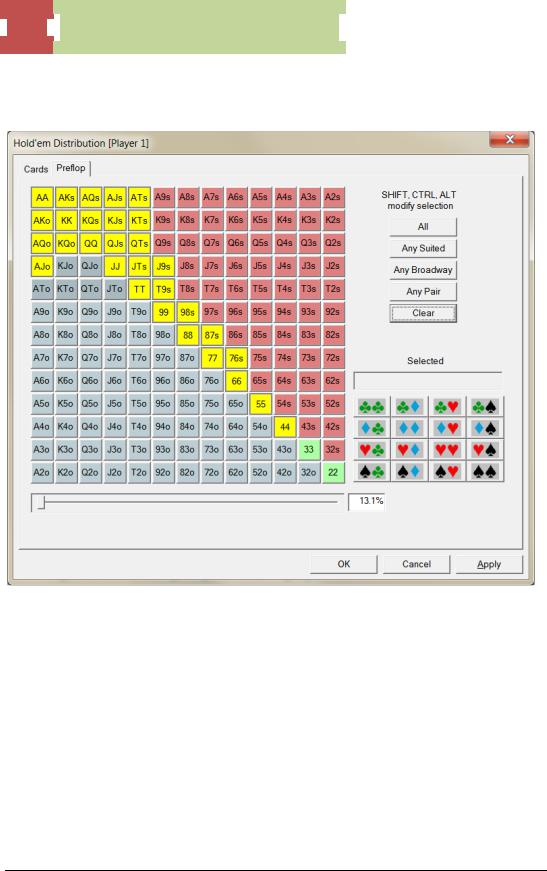
 48
48  Preflop: The Fundamentals
Preflop: The Fundamentals
Under the Gun (UTG)
Figure 1: UTG’s Raising Range in Yellow Highlights - 13.1%
UTG is the first player to act pre-flop, with three players having position on you—middle position (MP), cut off (CO) and the button (BTN). Since you will be out of position for most hands, it’s best to play with a tighter range than all other positions.
Hand Ranges
Here’s a conservative range of hands to play from UTG if you want to play at 23/18 or so. I recommend raising about 12-14% of hands.
1.All pairs 44 and higher
2.All suited broadways such as ATs, KTs, JTs
©2010 Aaron Davis and Tri Nguyen - All Rights Reserved.
http://www.DailyVariance.com
48
